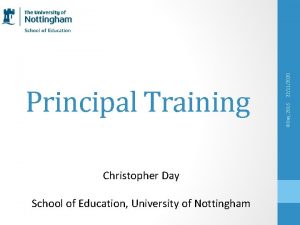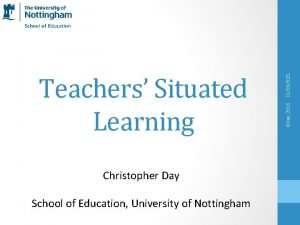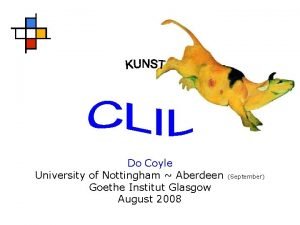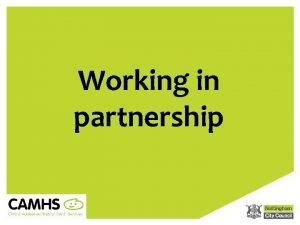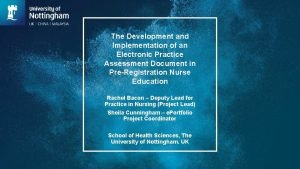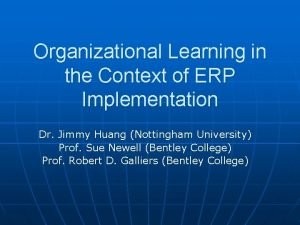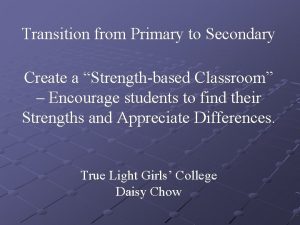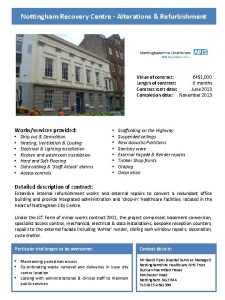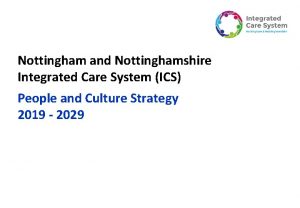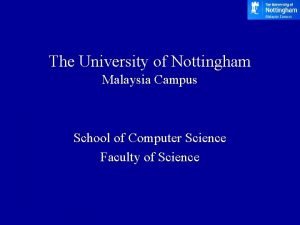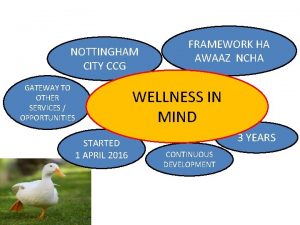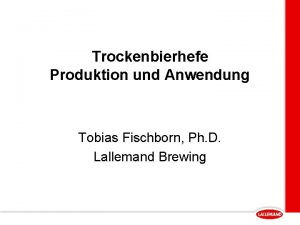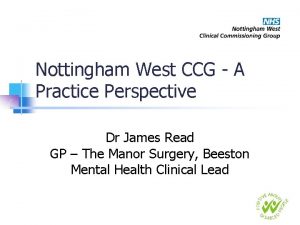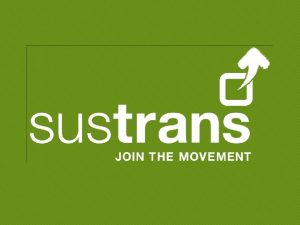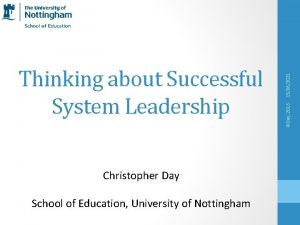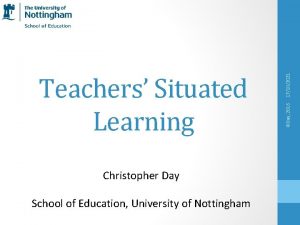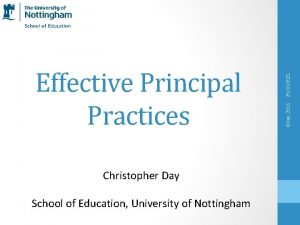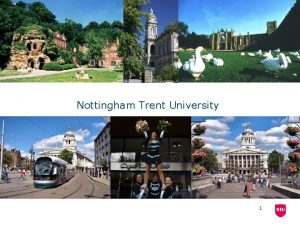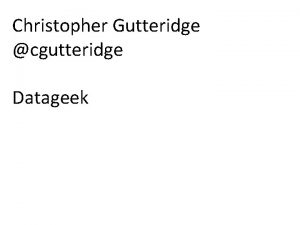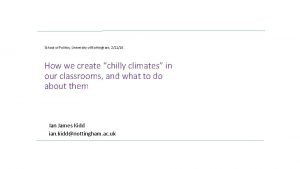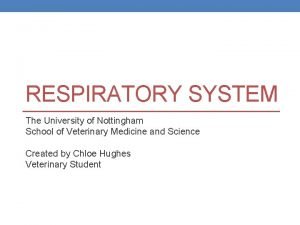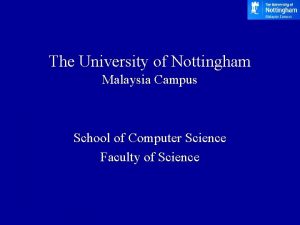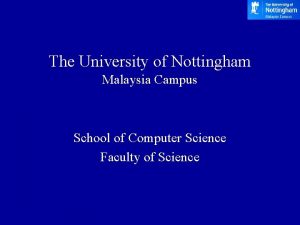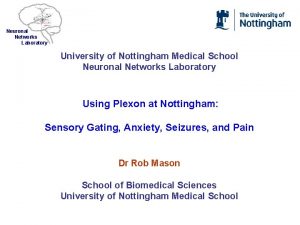Christopher Day School of Education University of Nottingham

































- Slides: 33

Christopher Day School of Education, University of Nottingham 11/03/2021 ©Day, 2016 Teachers’ Situated Learning

(Mc. Kinsey, 2007 & 2010) ©Day, 2016 Getting the right people into the teaching profession and developing them to become effective teachers have played a central role in enabling these systems to come out on top, and more importantly, keep getting better. 11/03/2021 1. Teacher Quality Matters

2. Defining Professional Learning and Development ©Day, 2016 • extend their emotional and intellectual career long commitment to the broader ethical and moral purposes of teaching in contexts of national reform • review and renew their sense of positive professional identity and professional capital • acquire and develop critically the values, dispositions, qualities, knowledge, skills, planning, practices and capacities for the everyday resilience needed to educate all children, young people and colleagues to their best within and across schools through each phase of their teaching lives • engage in ‘functional’ and ‘attitudinal’ professional learning and development. 11/03/2021 The process by which, as change agents, alone and with others, teachers:

©Day, 2016 11/03/2021 TALIS: Comparison of Impact and Participation by Types of Development Activity (2007 -08)

©Day, 2016 • Coaching (100%) • Understanding and use of data (56%) • Conflict management (39%) • Performance management and evaluation (39%) • Planning and Administration (29%) • Teaching skills (14%) 11/03/2021 Top Skills Identified as Necessary to Success

Excessive workload Rapid pace of change Unsupportive schools Pupil behaviour Problems with parents Too much poorly managed mandated change ©Day, 2016 • • • 11/03/2021 3. Factors which Damage Performance

Colleagues (63%) We have such a supportive team here. Everyone works together and we have a common goal to work towards. Personal support (95%) It helps having a supportive family who don’t get frustrated when I’m sat working on a Sunday afternoon and they want to go to the park. ©Day, 2016 Leadership (76%) It’s good to know that we have strong leadership who has a clear vision for the school. 11/03/2021 Positive Influences on Commitment

Pupil behaviour (64%) Over the years, pupils have got worse. They have no respect for themselves or the teachers. Pupil behaviour is one of the biggest problems in schools today. They know their rights and there’s nothing you can do. Leadership (58%) Unless the leadership supports the staff, you’re on your own. They need to be visible and need to appreciate what teachers are doing. ©Day, 2016 Workload (68%) It never stops, there’s always something more to do and it eats away at your life until you have no social life and no time for anything but work. 11/03/2021 Negative Influences on Commitment

©Day, 2016 • Relies on the one-shot workshop model • Focuses only on training teachers in new techniques and behaviours • Is not related to teachers’ specific contexts and curriculums • Is episodic and fragmented • Expects teachers to make changes in isolation and without support • Does not provide sustained teacher learning opportunities over multiple days and weeks (Darling-Hammond and Richardson, ASCD, 2009: 6) 11/03/2021 4. Ineffective Professional Development

©Day, 2016 • Deepens teachers’ knowledge of content and how to teach it to students • Helps teachers understand how students learn specific content • Provides opportunities for active, hands-on learning • Enables teachers to acquire new knowledge, apply it to practice, and reflect on the results with colleagues • Is part of a school reform effort that links curriculum, assessment, and standards to professional learning • Is collaborative and collegial • Is intensive and sustained over time 11/03/2021 Effective Professional Development

• Kretlow and Bartholomew’s (2010) review found that effective PLD needs to be strongly related to teachers’own contexts and in terms of their day to day concerns and their organisational contexts ©Day, 2016 1. Requires investment of time • Darling Hammond et al (2007) found that an average of 49 hours over a year boosted student achievement by 21 percentile points, whereas 5 -14 hours had no statistically significant effect on student learning. Teachers who received 80+ hours were more likely to put teaching strategies into practice than others. 11/03/2021 Effective PLD

©Day, 2016 3. Will benefit students most when it is • Collaborative • Supported by professional expertise • Sustained over time • Connects theory to practice • Involves teachers in designing teaching and learning activities whilst providing intensive support initially • Making some teachers leaders or ‘champions’ of their colleagues’ learning. ( Parr and Timperley, 2010; Day and Gu, 2014) 11/03/2021 2. Focuses directly on student outcomes AND Teachers’ motivational, identity, commitment, resilience and well-being needs

©Day, 2016 1. Relevant to their intellectual, emotional and practical teaching needs and/or those of the school 2. Organised and led by those who understand care how adult learners learn best 3. Integral to the dynamics of their school and departmental cultures 4. Timely 5. Provided in forms and at times that are convenient 6. Valuing and enhancing their sense of self-efficacy and agency 7. Likely to contribute towards improvements in their thinking and practice 8. Building their professional capital 9. Enhancing their positive sense of professional identity, commitment, and capacity for resilience 11/03/2021 Professional learning and development are more likely to be effective when they are perceived by individual teachers as

©Day, 2016 11/03/2021 Three Orientations of Professional Learning and Development

©Day, 2016 The culture of the workplace is a key factor in creating the conditions for building and sustaining teachers’ capacity and capability to exercise commitment and resilience. 11/03/2021 5. Sustaining Commitment: a key to quality

• Within school variation has greater effects on student achievement than between school variation. ©Day, 2016 11/03/2021 ©Day, 2016 • There are differences in culture between schools and between countries but the challenges are broadly the same.

©Day, 2016 to focus solely upon analysis of the functional (short term, instrumental) demands of the contexts in which teachers work risks failing to draw attention to their ‘attitudinal’ development. “…as a factor influencing change it is much more potent than functional development since it reflects, to varying degrees, acceptance of and commitment to the change…An ideally constituted professional development incorporates both attitudinal and functional development, since either without the other is unsatisfactory. ” (Evans, 2007: 33) 11/03/2021 6. Combining the Functional and the Attitudinal

©Day, 2016 11/03/2021

7. Taking Account of Life Phases Middle Professional Life Phase 8 -15 Managing Changes in Role and Identity: Growing Tensions Professional Life Phase 16 -23 Work-life Tensions: Challenges to Motivation and Commitment Later Professional Life Phase 24 -30 Challenges to Sustaining Motivation Professional Life Phase 31+ Sustaining/Declining Motivation, Ability to Cope with Change, Looking to Retire ©Day, 2016 Professional Life Phase 4 -7 Identity and Efficacy in Classroom 11/03/2021 Early Professional Life Phase 0 -3 Commitment: Support and Challenge

©Day, 2016 • Professional life phase 4 -7 years: Developing professional identity through enhancing role effectiveness 11/03/2021 • Professional life phase 0 -3 years: Learning which builds identity and classroom competence

11/03/2021 ©Day, 2016 Professional life phase 8 -15 years: defining work-life balance (watershed) a) targeting at their differentiated professional learning needs and help enhance their role effectiveness either as managers or as classroom teachers. b) professional and personal support and care within and outside the workplace which focussed upon improving their self-efficacy, morale

11/03/2021 ©Day, 2016 Professional life phase 16 -23 years: managing work-life tensions a) enhancing teachers’ role effectiveness were of value b) greater support from knowledgeable headteachers and colleagues in whom they could trust which focussed upon maintaining and increasing teachers’ morale and capacities to manage work -life tensions and sustaining their commitment and effectiveness

a) in-school support focussing upon mediating the effects of unsolicited and undesired external policy initiatives and assisting them in adjusting successfully to these 11/03/2021 ©Day, 2016 Professional life phase 24 -30 years: adjusting to change: a) targeting at strengthening their effectiveness as managers continued to be of importance

©Day, 2016 • focussing upon school leadership and cultures which provided for professional care and emotional wellbeing 11/03/2021 Professional life phase 31+: sustaining commitment

©Day, 2016 • Decisional capital : the ability to exercise wise judgements in the unpredictable processes of teaching and learning in the classroom. • Human capital: qualifications, experience and developing individual knowledge and skills. • Social capital: built through frequent productive interaction with colleagues within and outside the school through which trust is built. (Hargreaves & Fullan, 2012) 11/03/2021 8. Professional Capital

©Day, 2016 ‘ the capital that professionals acquire and accumulate through structured and unstructured experience, practice and reflection-capital that enables them to make wise judgments in circumstances where there is no fixed rule or piece of incontrovertible evidence to guide them’ (Hargreaves & Fullan, 2012: 93 -94) 11/03/2021 Focus on ‘Decisional Capital’

Key Influences ©Day, 2016 11/03/2021 Professional Life Phases Identity Decisional Capital Resilience Commitment

©Day, 2016 11/03/2021 9. Planning for Development

(Lieberman and Miller, 2008: 2) ©Day, 2016 “On-going groups of teachers who meet regularly for the purpose of increasing their own learning and that of their students” 11/03/2021 10. Professional Learning Communities

Features • Bringing people into an environment where § colleagues work together on the everyday tensions of teaching § new practices are constantly being created and learned rather than a fixed menu ©Day, 2016 • Focussing on the relationships and reversing the isolation of teachers • Providing a place for teachers to work together and connect with one another about their own work and the work of their students 11/03/2021 • Within & cross schools, districts or states

Understanding Complexity, Building Quality Professional Capital Occupational Professionalism Career Long Commitment BUILDING AND SUSTAINING TEACHER QUALITY Emotional Literacy Resilience Leadership and Culture The Functional and Attitudinal ©Day, 2016 11/03/2021 Professional Identity

• Students are not served well when a district retains teachers without regard to quality. Little can be achieved (and much might be lost) when a district succeeds in reducing teacher turnover if some of those teachers are incompetent, mediocre, disengaged, or burnt out. • Instead, student learning is the goal, and schools must seek to retain teachers who demonstrate that they are skilled and effective in the classroom, are committed to student learning, and are ready and able to contribute to the improvement of their school. (Johnson et al. , 2005: 2) ©Day, 2016 • ‘The physical retention of teachers, ‘in and of itself, is not a worthy goal’ 11/03/2021 Quality Retention

Christopher. Day@nottingham. ac. uk 11/03/2021 ©Day, 2016 Thank You!
 Christopher day nottingham
Christopher day nottingham Christopher day nottingham
Christopher day nottingham Day 1 day 2 day 3 day 4
Day 1 day 2 day 3 day 4 Do you want to dance indirect speech
Do you want to dance indirect speech University of nottingham parking permit
University of nottingham parking permit Do coyle
Do coyle Day 1 day 2 day 817
Day 1 day 2 day 817 Citizen portal nottingham
Citizen portal nottingham St christopher primary school coventry
St christopher primary school coventry St christopher primary school
St christopher primary school Bemh nottingham
Bemh nottingham Fallon sherrock smoking
Fallon sherrock smoking Pebblepad nottingham
Pebblepad nottingham Jimmy huang nottingham
Jimmy huang nottingham Dsl nottingham
Dsl nottingham Works perks nottingham city council
Works perks nottingham city council Beh team nottingham
Beh team nottingham Learning pit james nottingham
Learning pit james nottingham Npras nottingham
Npras nottingham Nottingham recovery centre
Nottingham recovery centre Nottingham and nottinghamshire ics
Nottingham and nottinghamshire ics Stacy johnson nottingham
Stacy johnson nottingham Dr nina lewis nottingham
Dr nina lewis nottingham Woodview children's home nottingham
Woodview children's home nottingham Bestwood and sherwood midwifery
Bestwood and sherwood midwifery Vanguard plus
Vanguard plus Nottingham progression flow chart
Nottingham progression flow chart Nottingham big wheel
Nottingham big wheel Pancreatic calcification
Pancreatic calcification Awaaz nottingham
Awaaz nottingham Nottingham ale hefe temperatur
Nottingham ale hefe temperatur Wellness in mind nottingham
Wellness in mind nottingham Manor surgery beeston
Manor surgery beeston Nottingham city hospital respiratory assessment unit
Nottingham city hospital respiratory assessment unit
